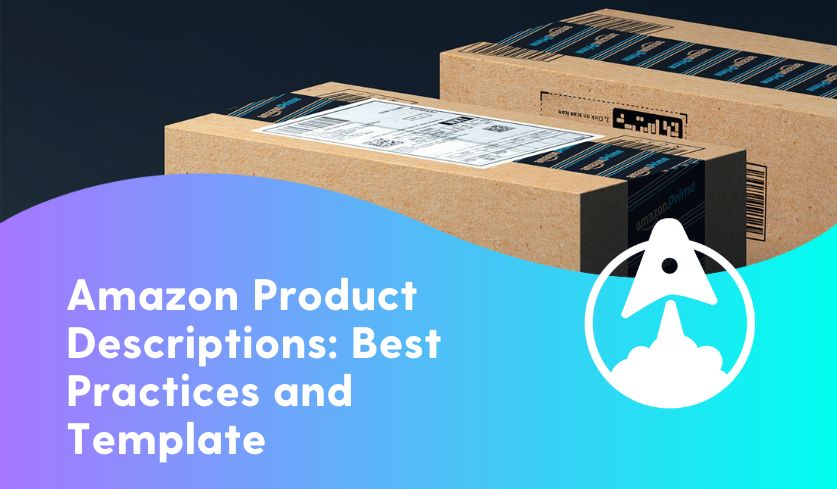Amazon is more than the world’s biggest online retailer — it’s also the biggest e-commerce search engine. Of course, customers use Amazon to shop, but plenty of folks make their way to the jungle-themed giant to research products, look up prices, and read reviews. It’s a key place for customers to learn all they can before making an educated purchasing decision. And just like SEO for other search engines, content is key to your Amazon product listings’ success.
Amazon product descriptions carry dual weight. They have to sell your product and help your listings climb to the top of search results. What’s more, your products will often compete among dozens, hundreds, or even thousands of products in a similar category. Here, you’ll learn the ins and outs of effective Amazon product descriptions: What they should include, how to look up keywords, and a template you can use to put these tips to work
Do product descriptions matter on Amazon?
Yes! Amazon product descriptions play an important role in a customer’s decision-making process because they:
- Clearly spell out the product details customers need to know
- Highlight your product’s key features and benefits
- Help customers visualize a product they can’t see or touch before buying
- Serve a similar function as content on Google, Bing, and other search engines
What do Amazon customers need to know about their products?
Product descriptions are entirely about convincing a customer that your product is worth their hard-earned money. To that end, Amazon shoppers need to know the following before clicking “add to cart.”
If the product fulfills their needs
When a customer can’t pick up a product or look at it in person before shopping, it can be difficult for them to know whether the item in question will truly work for them. Amazon product descriptions, along with photos and videos, help your target audience make the best decision about whether a product will work for them.
Let’s say a customer is shopping for candles — there are millions of candles to choose from. Amazon product descriptions help the customer eliminate which candles won’t fit their needs while making it clear which ones will do the trick. The listing title does a lot of the heavy lifting here, detailing important information about the product color, scent, and size right away.
Let’s look at another example: Suppose a customer is shopping for a Bluetooth speaker for their next party. Let’s also say the customer wants something that has a little pizzazz to it, in the form of colorful LED lights. If your speaker only shines a single color, it doesn’t fit that customer’s needs, and they could end up returning it. Your Amazon product description is the place to list these important details that could make or break someone’s purchase.
If it will fit
Whether it’s a dress that’s too tight, a desk that’s too deep, or a lamp that’s too tall, size is among the top reasons why shoppers return items. Amazon product descriptions play a crucial role in minimizing these types of returns. Practical measurements like height, length, and depth are key to include in your listing. For clothing, a size chart that covers the bust, waist, hip, arm circumference, inseam, and more makes a difference.
It’s not just clothes and furniture that should get the “dimension” treatment — you should apply this logic to all items you sell. You don’t want a customer returning a power bank you sell because it’s too thick to fit in their pocket, even if its size has little bearing on its functionality.
If it will appear the same in person as it does online
Nearly half of all online returns are because an item didn’t match expectations once it arrived. Including images and video when you list a product on Amazon goes a long way to help set expectations, but it’s only the start. When writing your product descriptions, you should include these details as well. Use your product description to reinforce what shoppers can expect.
The components of an Amazon product description
It’s important that the product’s details, and how the product is used, are communicated clearly. This ensures that your customer will understand, too — and increases the likelihood that they’ll buy your product and not a competitor’s. This also helps reduce return rates because it sets expectations for your product from the get-go.
To that end, it’s best to optimize the three main areas of an Amazon product description: your product title, bullet points, and a detailed product description.
The title
Titles on Amazon are among the most important components to optimize and write well. When someone searches for dining room chairs, stemless wine glasses, or a grilled cheese cookbook, they’re going to scan the titles on the page for the results. The one that most closely matches what they’re looking for gets the all-important click that brings them one step closer to checkout.
To that aim, your product title should prioritize the keyword you’re targeting toward the front of the description. It should also include essential information and some description of the item and what makes it stand apart. This can be quite the challenge, as Amazon says titles between 60 and 80 characters are the most effective.
Bullet points
Directly underneath the title in a listing, you’ll find bullet points that concisely list out the most important product features and benefits. This area should be reserved for the most important aspects of your product listing, such as purpose, size, and shape. Think of this as the place to make that great first impression!
Take a beard trimmer, for example. Shoppers need to know right away if the trimmer comes with attachments, if it’s rechargeable or plugs into an outlet, offers speed modes, and on which parts of the body it can be used beyond the beard. This area of an Amazon product description is the perfect place to hash out all those important details up front.
Here’s another great example from Bose, which uses bullet points to drive home the most important factors that speaker shoppers need to know before buying. They detail the product’s sound quality, waterproof rating (hello, beach parties!), and rechargeable battery, among other make-or-break details that convince a shopper to stick around.
Detailed product description
What makes your product different from all the others on Amazon and other e-commerce stores? This is the place to show that off!
The detailed product description is where you can put a whole lot more info than what the bullet points allow. Use this space to elaborate on the information you started discussing in the bullet points. This is the place for sales-y, flowery language about the product at hand. Feel free to flex your creative muscle here — just don’t stray too far or go too off-script. It’s key that all your details are still easy to understand, concise, and communicated clearly.
What about Amazon A+ content?
Amazon A+ content means your product description is enhanced with extra copy, images, and video. It can make a big difference to your would-be customers, as these pages are easier to digest and offer an extra opportunity to make the case for your product’s “why.” They’re especially powerful for boosting your conversion rates.
A+ content comes with its own guidelines separate from a typical Amazon description. But many of the same fundamentals apply: A+ content should also be clear, concise, accurate, and informative.
Is there a difference between Amazon and Google’s algorithms?
At their core, Amazon and Google have quite similar algorithms — but they don’t work identically, and more importantly, customers use them differently.
Amazon’s algorithm is called A10, and it’s updated quite frequently to keep up with what shoppers are searching and buying. Similar to Google, Amazon sellers’ longevity, customer reviews, and authority are taken into account, among other factors.
But the devil isn’t in those details — it’s in how searchers use each platform. That’s because the purpose of each platform is different. People come to Amazon to shop (primarily) and use the platform to look up information about a product they want to buy. Google and other search engines are primarily for when folks are still in “discovery” mode, or when they set out looking for initial information. Yes, people shop on Google, but it’s not the platform’s primary function.
Because Amazon is primarily for shopping and Google and other search engines are primarily for research and discovery, the way someone types a query into each website may differ. For example, someone looking for a shea butter lotion might search for the best options on traditional search engines, but once they know a brand they want to try, they may conduct searches on Amazon for Palmer’s shea butter lotion.
How do I look up Amazon keywords?
Amazon doesn’t have a keyword research tool, but there are a number of third-party websites you can use to look up keywords used on Amazon. Some of these options include:
- Keyword ID browser extensions
- Keyword planner and lookup platforms
- Conducting competitor analysis to see which keywords your competitors are using
Pro tips for writing Amazon product descriptions
- Pay attention to keywords. Amazon SEO requires way more investment than just writing an Amazon product description, but keywords are still quite important. Similar to Google’s guidelines, don’t stuff your description full of keywords. Instead, focus on the main one and scatter similar, related keywords naturally throughout your description.
- Keep it simple. While selling to your customer is important, it’s even more important to be straightforward. Don’t use a complicated metaphor in place of a straightforward how-to. And when in doubt, be direct.
- Don’t skimp on spelling and grammar. Correct spelling and sound grammar build trust. If your product listing is full of typos, it erodes customer trust in your listing.
We’re not just saying that — it’s science. A small study published in Frontiers in Psychology found a direct correlation between a reader’s trust in a piece of text and the number of typos in that text. The more typos a 100-word passage contained, the less likely a reader was to rate the information contained within as trustworthy. While the study was small, with only 100 participants, its findings are in line with traditional wisdom. We’re often told that obvious typos are signs of scams and spam. That logic translates to Amazon listings (and any other content full of typos).
Amazon product description template
Keep in mind — this template doesn’t account for extra features or content in images. There’s a whole world to explore there! But for those who are in need of a basic Amazon product description template, the below combination of bulletpoints and descriptive paragraph can go a long way.
Write an optimized product title that accurately describes the item you’re selling, the brand name, and other pertinent information. This title should be between 60 and 80 characters long.
- Bullet point 1 (500 character count limit per bullet for sellers, 250 character count limit per bullet for vendors)
- Bullet point 2
- Bullet point 3
- Bullet point 4
- Bullet point 5
It is recommended to not go over 1,000 total characters for all five bulletpoints.
Follow your bullet points with a descriptive paragraph that naturally includes keywords relevant to your audience. This paragraph should reiterate the features and benefits of your product while highlighting what about your company makes shopping from you easier, such as a warranty or customer service.
What about reviews?
Be sure not to include reviews in your Amazon product description because those are customer-submitted, and they live on a separate section of the page. For the best overall results on Amazon, consider building A+ pages rich with images and video that can help you build a compelling story.
Get selling with optimized Amazon product descriptions
There’s being a great seller, and then there’s being a great writer. Well-written content is one of the best ways to cut through the clutter on Amazon and reach more customers. Optimized descriptions that focus on what customers need to know will drive sales and discourage returns. And when it comes time to keep that content fresh, reach out to The Stellastra Effect. With years of experience writing product descriptions for all kinds of online sellers and marketplaces — including Amazon — we’re here to make your products stand out from the pack.







